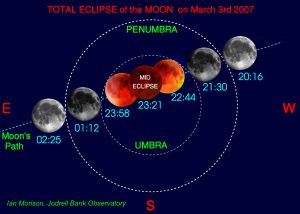A Total Eclipse of the Moon: March 3rd 2007
28th February 2007
If the sky is clear on the night of March the 3rd we will be able to witness the first total eclipse of the Moon visible from the United Kingdom for three years and the best since January 2001. With the Moon's colour during totality ranging from dark coppery-brown to bright orange it can be a most beautiful sight. Though not as spectacular as a total Solar eclipse, it will be visible from the whole dark side of the Earth and is totally safe to observe. No protective filters are needed and the Moon will appear considerably less bright than the normal Full Moon.
During the period of totality, from 22:24 to 23:58, the Moon is only illuminated by light that has filtered through the Earth's atmosphere and its appearance depends on the amount of dust in the atmosphere: following the eruption of Mount Pinatubo in 1992, which released large amounts of volcanic ash into the atmosphere, the eclipsed Moon was nearly invisible. As the Earth has not had a major eruption for some years we can expect an impressive sight!
Ian Morison of the University of Manchester's Jodrell Bank Observatory explains: "If the Earth had no atmosphere the Moon would become invisible when it fully enters the Earth's shadow. However, light refracted and scattered through the atmosphere can still illuminate the Moon though with far reduced brightness. As blue light is scattered by the atmosphere more than red light (which is why our skies are blue) the light that remains is predominately red and orange - the colour of the Sun when close to the horizon. If there were astronauts on the surface of the Moon looking towards the Earth during a total lunar eclipse they would see a black disc surrounded by a bright red ring. It is the light from this ring that we see reflected by the Moon's surface."
The Moon will start to be partially eclipsed at 20:16 as it enters the Earth's penumbra, but the effects will be difficult to see. Only when part of the Moon's disc enter the full shadow region, the umbra, does the reduction in brightness and the colouration become obvious. The Moon will star to enter the umbra at 21:30 and be fully immersed in the Earth's shadow by 22:44. Mid-eclipse is at 23:21 and the Moon will begin to emerge from the umbral region at 23:58. The eclipse will be finally over at 02:25.
The eclipse can be observed anywhere, even in the centre of a large town, but dark skies will enable it to be seen at its best. The Moon will be seen in the south at an elevation of ~ 44 degrees. Binoculars would be a useful aid, but are not needed.
A total eclipse of the Moon occurs when the Earth lies precisely between the Moon and the Sun, and can thus only happen at full Moon. As there is a full Moon every 29 and a half days one might wonder why there is not an eclipse each month. This does not happen because the Moon's orbit is inclined at 5 degrees to the Earth's orbit around the Sun and the Earths shadow usually passes above or below the Moon.
Further Information:
Ian Morison
Jodrell Bank Observatory,
University of Manchester.
Phone Day: 01477 572610 or 01477 571321
Phone Evening: 01625 428340
e-mail: Ian.Morison@manchester.ac.uk



